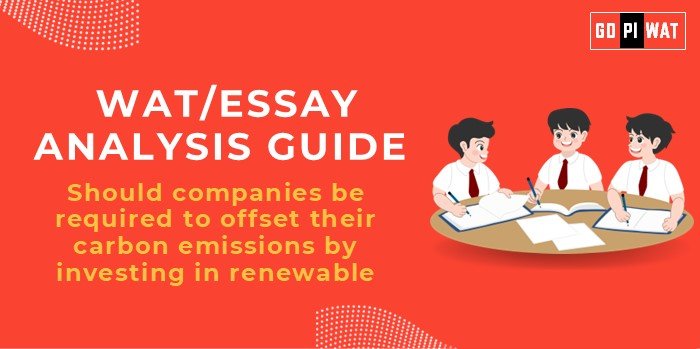📋 Written Ability Test (WAT)/Essay Analysis Guide
🌍 Understanding the Topic’s Importance
The essay connects with themes of corporate responsibility, climate action, and economic sustainability, reflecting critical global challenges.
🕒 Effective Planning and Writing
- Time Allocation:
- Planning: 5 minutes
- Writing: 20 minutes
- Review: 5 minutes
- Contrast Approach: “Industries drive economic growth but remain among the largest contributors to climate change. Balancing emissions through renewable investments represents a contentious yet vital strategy.”
- Timeline Approach: “Since the Paris Agreement, the urgency for carbon neutrality has grown, sparking debates on corporate roles in renewable energy investment.”
📖 Structuring the Essay Body
- Paragraph 1: Achievements
- Highlight success stories of companies achieving net-zero targets via renewables.
- Paragraph 2: Challenges
- Discuss high costs, regulatory gaps, and potential inequities.
- Paragraph 3: Future Outlook
- Explore innovations and collaborative strategies for sustainable carbon management.
📄 Concluding Effectively
- Balanced Perspective: “Mandating offsets encourages renewable adoption but requires equitable frameworks for effective implementation.”
- Future Focused: “The pathway to carbon neutrality lies in innovation, corporate commitment, and global cooperation.”
💡 Recommendations for Sustainable Progress
- Develop uniform global standards for carbon offsets.
- Subsidize renewable projects to support smaller businesses.
- Promote transparency in offset accounting.
📝 Sample Short Essays
Balanced Perspective:
“While offset mandates promote sustainability, equity in implementation is crucial to avoid unfair burdens on small businesses.”
Solution-Oriented:
“Mandatory offsets can revolutionize renewable energy if paired with supportive policies and global standards.”
Global Comparison:
“Carbon offsetting mirrors successful strategies in nations like Sweden, showcasing its potential for global emission reductions.”


